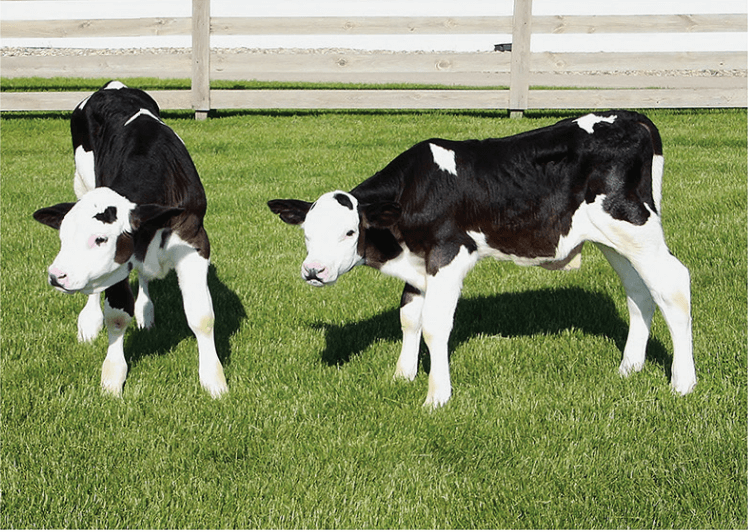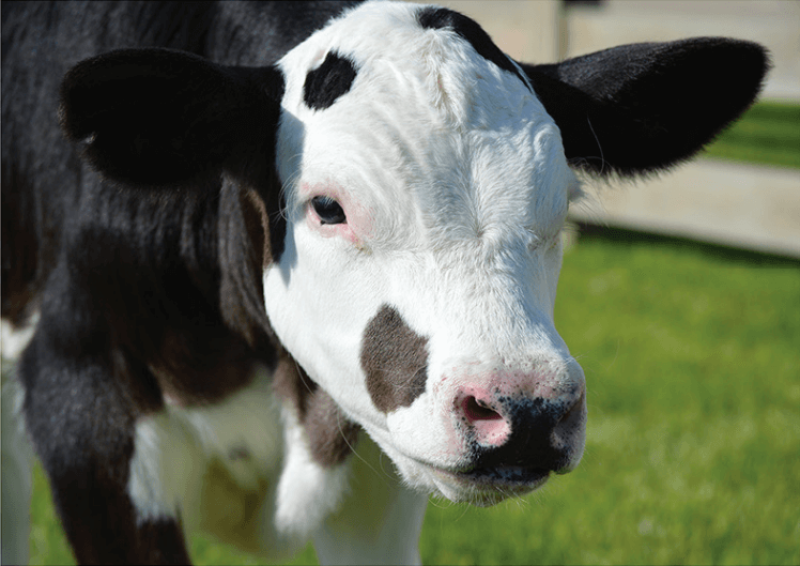Critics have called it the “hornless Frankencow,” but scientists and animal welfare advocates have a different view of the latest innovation in genetic engineering.
Polled livestock—animals without horns in normally horned species—have been around for ages. While farmers have been able to crossbreed beef cattle, such as Aberdeen Angus, so they do not have dangerous horns, they’ve had less luck in the most productive dairy breeds, particularly Holsteins, the world’s highest producing dairy cow.
Now biotechnology is lending a hand. A team of scientists have announced in a letter published in Nature Biotechnology that they have used gene editing to create hornless cows. The cows show no ill effects of the procedure.
The news has reignited the debate over the question of what is natural and how these animals should be regulated. The cows were created by scientists working for the small biotech company Recombinetics, as well as researchers at the University of Minnesota. The animals are not transgenic; no “foreign” genes were inserted to create the hornless. Rather, this represents the first time livestock has been successfully gene edited; other animals have been altered and improved via gene editing techniques but all were used for biomedical research purposes.
These hornless cows have been in the works for years, but this latest publication represents the first time a peer-reviewed study has been published on the results. Arguably the most important finding in this paper was that a genome wide screen of the cows revealed that the process resulted in no off-target effects.
Some scientists and many activists have expressed concern that the editing tools (in this case TALENs but similar concerns exist for CRISPR too) used to create the hornless cows and other animals may result in unintended consequences. The worry is that gene editing enzymes will edit regions of the genome that are similar in sequence to the desired target instead of the exact targeted region. But the authors found none of these issues in their cows.
William Muir, a professor of genetics in the department of animal sciences at Purdue University, who was not involved with the study, explained the significance of this finding to GLP’s sister site Genetic Expert News Service (GENeS):
…lack of off-target effects means that there are no unintended consequences, so we don’t have to worry about what else has changed! This is not a transgenic animal, but simply the insertion of a gene that naturally exists in cattle. With transgenic animals, genes can be inserted from other species and the technique is much less precise than gene-editing since the insertion site of the transgene is random and not known, thus unintended consequences can occur if the gene inserts itself into the wrong area(s).
A veterinarian also examined the cows to ensure they were in good health. This all means that biotechnology may be able to deliver on a long standing promise to improve animal welfare by eliminating genes for horns in livestock. Most dairy cows are born with horns, but the horns need to be removed so the cows don’t injure each other and farmers. But the practice is not considered to be very humane. Here is a description from the animal rights activist group People for the Ethical Treatment (PETA):
This procedure is extremely traumatic to young calves, who are often just a few weeks old when their horn buds are burned or cut out of their heads. Older cows fare even worse. Dehorning in mature cattle usually requires amputation of the horn, which has already attached itself to the skull.
Scientists are excited about the potential to improve animal welfare on farms. “The most humane way to dehorn a calf is to use genetics,” remarked James Reecy, a professor of animal science at Iowa State University to GENeS and Muir told GENeS the study’s results are, “…a win-win both for the animal and for the farmer.”
The traditional practice of forcibly removing forms is considered inhumane by many consumers, which has prompted Walmart, Krogers, Starbucks and Nestle to implement policies to prioritize products from polled cows. Even farmers don’t like doing it, as the practice is seen as more of a necessary evil to protect themselves and other animals. Whether these firms will embrace cows whose horns have not been forcibly removed but are engineered that way is an open question.
Why gene editing?

For breeds used in dairy, only about 6 percent are born naturally polled. For decades, farmers, breeders and scientists have tried to spread the polled gene throughout the dairy cow breeds—like Holsteins—but their efforts have been mostly fruitless and bad for farmers, the study’s authors explained:
The increased use of polled Holstein sires has been impeded by their lower estimated breeding values (a genetic merit score) for milk production, likely a result of genomic drag due to polled introgression from non-dairy animals. Even if producers ignore the substantial value difference of $252 per lactation cycle between horned and polled animals, it would still take >20 years of classic breeding to reach a frequency of 50% polled animals.
In short, farmers would need to ignore the massive economic loss and wait decades for even half the cows to be naturally bred to be born without horns. It is simply not a feasible option. Gene editing allows scientists to take this one desirable trait that is only in a minority of members of the species, and insert it into an elite milk producer.
These cows are…natural?
Unlike many genetically modified organisms like the AquAdvantage salmon, a transgenic fish that received a gene from similar species, these gene edited cows received DNA from within their own species. According to several of the scientists that commented to GENeS, this raises the possibility that these cows will be considered as ‘natural’—a distinction which could expedite the regulatory process.
Iowa State’s Reecey said he also believes these gene edited cows should be considered natural:
This case also opens an interesting discussion, if gene editing is used to introduce a naturally occurring mutation in a breed that did not harbor it, should it be considered natural? I believe that it should be.
Willard Eyestone, a researcher at Virginia Tech, agrees, noting it presents a challenge for regulators.
Gene-editing, at least as described here, does not introduce any gene sequences into lines of horned cattle that are not already present (and thus consumed) in naturally polled cattle. Moreover gene-editing is “footprint free” and leaves no trace of residual gene sequence in the animal that would indicate it was the product of gene-editing. The resulting gene sequence of the edited, polled animals is identical to that of naturally-occurring polled cattle. … Regulatory agencies must decide if this sort of change is subject to regulation according to the process by which it was achieved, or by the resulting gene sequence.
Muir predicts the regulatory process will be swift. In the past, the USDA has chosen not to regulate crops that have been altered by TALENs, and in April 2016 the agency announced it would not regulate a mushroom altered with CRISPR gene editing. In these cases the agency chose not to regulate these plants in part because they don’t contain foreign DNA. A similar statement could be made about these gene edited polled cows, but there’s the possibility animals will be viewed differently than cows. The FDA, which took years to approve GMO salmon and is still blocking its import (although as mentioned above these cows are very different than the AquAdvantage salmon), will also weigh in.
There’s also another wrinkle to these cows. Unlike genetically engineered seeds, which are bought and planted new each year, these cows may be traditionally bred with horn dairy cows to spread the polled genes. It would therefore be the descendants of gene edited cows that appear on farms and act as a source of dairy and not gene edited cows directly—a distinction that is sure to cause much debate in the future.
Nicholas Staropoli is the associate director of GLP and director of the Epigenetics Literacy Project. He has an M.A. in biology from DePaul University and a B.S. in biomedical sciences from Marist College. Follow him on twitter @NickfrmBoston.































